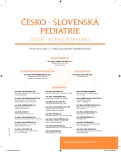-
Medical journals
- Career
How many adolescents in the Czech Republic are endangered by brain damage due to alcohol abuse?
Authors: L. Csémy 1; K. Nešpor 2
Authors‘ workplace: Oddělení léčby závislostí – muži, Psychiatrická nemocnice Bohnice, Prahaprimář MUDr. K. Nešpor, CSc. 2; Laboratoř sociální psychiatrie, Psychiatrické centrum Prahavedoucí PhDr. L. Csémy 11
Published in: Čes-slov Pediat 2013; 68 (6): 380-384.
Category: Actual Topic
Overview
The brain of adolescents is much more vulnerable by alcohol than in the years to follow. Drinking of alcohol, especially intermittent drinking of high doses (bender, binge drinking) represent a high risk for the brain of adolescents, their education and professional fulfillment in the society. Based on representative data collected in the Czech Republic within the framework of the ESPAD study in 2011 it may be noted that at least 22.8% of adolescents have participated in binge drinking three or more times during the last month. That would be almost 50 thousand individuals in the population born in the years 1994 and 1995. Almost 40% of adolescents at the age of 15 and 16 years first experienced alcohol even before they were 12, which increases brain vulnerability even further. The disturbing observation indicates that absolutely most adolescents drink alcohol regularly despite the fact that it is unlawful.
The given observations have far-reaching consequences in the health, economic and social area. It should motivate all those involved to better prevention in the family (Nešpor and Csémy, 2013), at school, and especially on the level of society as a whole.Key words:
alcohol, adolescence, binge drinking, brain, cognitive functions
Sources
1. Dietze P, Jenkinson R, Aitken C, Stoové M, Jolley D, et al. The relationship between alcohol use and injecting drug use: impacts on health, crime and wellbeing. Drug Alcohol Depend 2013; 128 (1–2): 111–115.
2. Hermens DF, Lagopoulos J, Tobias-Webb J, De Regt T, Dore G, et al. Pathways to alcohol-induced brain impairment in young people: a review. Cortex 2013; 49 (1): 3–17.
3. Jacobus J, Thayer RE, Trim RS, Bava S, Frank LR, Tapert SF. White matter integrity, substance use, and risk taking in adolescence. Psychol Addict Behav 2013; 27 (2): 431–442.
4. Krista M. Lindahl, Erika R. Gilbart, Natasha E. Wright and Skyler Shollenbarger: Dare to delay? The impacts of adolescent alcohol and marijuana use onset on cognition, brain structure, and function. Front Psychiatry, 01 July 2013. doi: 10.3389/fpsyt.2013.00053.
5. Nešpor K. Prevence návykových nemocí v rodině. Alkoholizmus a drogové závislosti (Bratislava) 2012; 47 (2): 115–120. Volně dostupné na www.drnespor.eu.
6. Nešpor K, Csémy L. Tělesná aktivita a návykové nemoci: překvapivá zjištění. Bulletin praktických lékařů ČR 2012; 22 (6): 52–54.
7. Nešpor K, Csémy L. Kolik dospívajících je v Česku ohroženo trvalým poškozením poznávacích funkcí v důsledku kouření marihuany? Prakt Lék 2013; 93 (1): 21–22.
8. Nešpor K, Csémy L. Prevence problémů působených alkoholem v rodině – nová zjištění. Prakt Lék 2013; 93 : 57–58.
9. Parada M, Corral M, Mota N, Crego A, Rodríguez Holguín S, Cadaveira F. Executive functioning and alcohol binge drinking in university students. Addict Behav 2012; 37 (2): 167–172.
10. Scholes-Balog KE, Hemphill SA, Kremer P, Toumbourou JW. A longitudinal study of the reciprocal effects of alcohol use and interpersonal violence among Australian young people. J Youth Adolesc 2013, Jan 26. [Epub ahead of print].
11. Wong SS, Zhou B, Goebert D, Hishinuma ES. The risk of adolescent suicide across patterns of drug use: a nationally representative study of high school students in the United States from 1999 to 2009. Soc Psychiatry Psychiatr Epidemiol 2013, Jun 7. [Epub ahead of print].
12. Xiao L, Bechara A, Gong Q, Huang X, Li X, et al. Abnormal affective decision making revealed in adolescent binge drinkers using a functional magnetic resonance imaging study. Psychol Addict Behav 2013; 27 (2): 443–454.
13. Zalesky A, Solowij N, Yücel M, Lubman DI, Takagi M, et al. Effect of long-term cannabis use on axonal fibre connectivity. Brain 2012; 135 (Pt 7): 2245–2255.
Labels
Neonatology Paediatrics General practitioner for children and adolescents
Article was published inCzech-Slovak Pediatrics

2013 Issue 6-
All articles in this issue
- Minimally invasive repair of pectus excavatum
- Therapy of acute cough in children – evidence based review
- How many adolescents in the Czech Republic are endangered by brain damage due to alcohol abuse?
- Radiological diagnostics of urinary tract in children at the Pediatric Faculty, Charles University in Prague in the second half of twentieth century has been described
- Czech-Slovak Pediatrics
- Journal archive
- Current issue
- Online only
- About the journal
Most read in this issue- Minimally invasive repair of pectus excavatum
- Therapy of acute cough in children – evidence based review
- Radiological diagnostics of urinary tract in children at the Pediatric Faculty, Charles University in Prague in the second half of twentieth century has been described
- How many adolescents in the Czech Republic are endangered by brain damage due to alcohol abuse?
Login#ADS_BOTTOM_SCRIPTS#Forgotten passwordEnter the email address that you registered with. We will send you instructions on how to set a new password.
- Career

